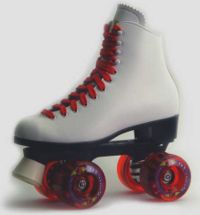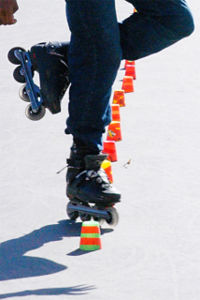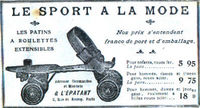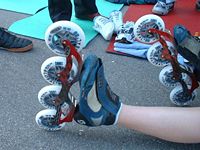Roller skating
2008/9 Schools Wikipedia Selection. Related subjects: Recreation
Roller skating is the travelling on smooth terrain with roller skates. It is a form of recreation as well as a sport, and can also be a form of transportation. Skates generally come in two basic varieties: inline skates, and traditional quad skates, though some have experimented with a single-wheeled "quintessence skate" or other variations on the basic skate design, like the booster blades.
History
The first recorded use of roller skates was in a London stage performance in 1743. The inventor of this skate is lost to history. The first recorded skate inventor was Jean-Joseph Merlin, who demonstrated a primitive inline skate with metal wheels in 1760. The first patented roller skate design was patented in France by M. Petitbled, in 1819. These early skates were similar to today's inline skates, but they were not very maneuverable; it was very difficult with these skates to do anything but move in a straight line and perhaps make wide sweeping turns. During the rest of the 19th century, inventors continued to work on improving skate design.
The four-wheeled turning roller skate, or quad skate, with four wheels set in two side-by-side pairs, was first designed in 1863 in New York City by James Leonard Plimpton in an attempt to improve upon previous designs, The skate contained a pivoting action using a rubber cushion that allowed the skater to skate a curve just by leaning to one side. It was a huge success, so much that the first public skating rink was opened in 1866 in Newport, Rhode Island with the support of Plimpton. The design of the quad skate allowed easier turns and maneuverability, and the quad skate came to dominate the industry for more than a century.
Arguably, the most important advance in the realistic use of roller skates as a pleasurable pastime took place in Birmingham, England in 1876 when William Bown patented a design for the wheels of roller skates. Bown's design embodied his effort to keep the two bearing surfaces of an axle, fixed and moving, apart. Bown worked closely with Joseph Henry Hughes, who drew up the patent for a ball or roller bearing race for bicycle and carriage wheels in 1877. Hughes' patent included all the elements of an adjustable system. These two men are thus responsible for modern day roller skate and skateboard wheels, as well as the ball bearing race inclusion in velocipedes -- later to become motorbikes and automobiles.
Another improvement came in 1876, when the toe stop was first patented. This provided skaters with the ability to stop promptly upon tipping the skate onto the toe. Toe stops are still used today on most quad skates and on some types of inline skates.
Roller skates were being mass produced in America as early as the 1880s, the sport's first of several boom periods. Micajah C. Henley of Richmond, Indiana produced thousands of skates every week during peak sales. Henley skates were the first skate with adjustable tension via a screw, the ancestor of the kingbolt mechanism on modern quad skates.
In 1884 Levant M. Richardson received a patent for the use of steel ball bearings in skate wheels to reduce friction, allowing skaters to increase speed with minimum effort. In 1898, Richardson started the Richardson Ball Bearing and Skate Company, which provided skates to most professional skate racers of the time, including Harley Davidson (no relation to the Harley-Davidson motorcycle brand). (Turner and Zaidman, 1997).
The design of the quad skate has remained essentially unchanged since then, and remained as the dominant roller skate design until nearly the end of the 20th century. The quad skate has begun to make a comeback recently due to the popularity of roller derby and jam skating.
In 1979 Scott Olson and Brennan Olson of Minneapolis, Minnesota came across a pair of inline skates created in the 1960s by the Chicago Roller Skate Company and, seeing the potential for off-ice hockey training, set about redesigning the skates using modern materials and attaching ice hockey boots. A few years later Scott Olson began heavily promoting the skates and launched the company Rollerblade, Inc.. During the late 1980s and early 1990s, the Rollerblade-branded skates became so successful that they inspired many other companies to create similar inline skates, and the inline design became more popular than the traditional quads. The Rollerblade skates became synonymous in the minds of many with "inline skates" and skating, so much so that many people came to call any form of skating "Rollerblading," thus becoming a genericized trademark.
For much of the 1980s and into the 1990s, inline skate models typically sold for general public use employed a hard plastic boot, similar to ski boots. In or about 1995, "soft boot" designs were introduced to the market, primarily by the sporting goods firm K2 Inc., and promoted for use as fitness skates. Other companies quickly followed, and by the early 2000s the use of hard shell skates became primarily limited to the aggressive skating discipline.
The single-wheel "quintessence skate" was made in 1988 by Miyshael F. Gailson of Caples Lake Resort, California, for the purpose of cross-country ski skating and telemark skiing training. Other skate designs have been experimented with over the years, including two wheeled (heel and toe) inline skates, but the vast majority of skates on the market today are either quad or standard inline design.
Inline skating
Inline skates usually have 4 or 5 wheels, arranged in a single line. Most commonly, if they have a stop, it is a heel stop. Inline skating is often done on the same surfaces as skateboarding: on the road, sidewalk, various street furnishings like fences and steps, and on special tracks and areas. Some inline skaters compete in artistic skating events, though quads are still more typical for that use. Inline skates for artistic use tend to be designed more as an analog of the ice skate or artistic quad skate design, with a toe stop and rockered wheels.
The growth of inline skating in the United States was explosive in the early 1990s, but since 1996 sales have dropped as the market became saturated, many retailers failed to offer lessons on how to use the heel brake effectively and the sport's trendy status began to fade. Among children, inline skates were supplanted in popularity by new designs of kick scooters; meanwhile for adolescents there was a resurgence in the popularity of skateboarding. Today inline skaters can be found sharing public and private skateparks with skateboarders in cities around the world.
Because inline skating is associated with a variety of potential injuries (particular wrist and other orthopedic fractures), proper safety equipment is strongly recommended, including wrist guards, knee, elbow pads, a helmet. New skaters should consider getting rollerblading lessons from certified instructors.
Aggressive Skating
In addition to speed, fitness, artistic, or recreational skating, some skaters prefer aggressive skating. Aggressive skating is also often referred to by participants as rollerblading,blading, rolling,or freestyle rolling and includes a variety of grinds, airs, slides and other advanced skating maneuvers. It also includes "vert", "park" and "street skating" which refer to tricks performed on almost any obstacle. Street skating specifically refers to tricks performed on non-allocated obstacles (i.e. not skate parks). There are a three major types of aggressive inline skates: hard boots,soft boots, and skeletal skates (e.g Xsjado, pronounced "shadow"). Hard boots are very rigid and often heavy compared to speed skates and recreational skates. Soft boots offer more flexibility than hard boots, but are normally just as heavy. Xsjado skates were first released in 2004 and were designed by Shane Coburn (the company was recently acquired by The Powerslide Conference).
Aggressive inline has been on a slight decline overall for some time. However, during 2000-2003 there was a major increase in hope for the sport when street skating became increasingly popular. At this time professional skaters including Brian Shima, Jeff Stockwell, Chris Haffey, Aaron Feinberg, and Alex Broskow among others were pushing unseen boundaries in performing seemingly impossible and dangerous stunts in mostly street settings. In addition, the IMYTA (I Match Your Trick Association) provided a venue for skaters to demonstrate these tricks. The IMYTA held contests at a street location and the skaters would have to match each trick in the first round of skating or be eliminated. The progression continued with the pool of skaters dwindling and more dangerous and difficult tricks would then be performed and a winner declared. What competitions such as the IMYTA did do however was to encourage skaters from many different countries to set up their own local real street competitions.
Free skating
A skating category that lies somewhere between aggressive and recreational skating, free skating, also known as urban skating or free riding, includes many tricks such as jumps and slides, but not other tricks such as grinds. The emphasis of free skating is getting from A-to-B by the fastest possible route, by skating quickly through city streets and negotiating all obstacles. The boots on skates suitable for free skating tend to be more rigid for better leg support, like the aggressive skate, whilst the wheels tend to be small, like those found on recreational skates, and the frames short, like those found on hockey skates. Popular brands of freeskate include Salomon's FSK series, the RollerBlade .
Slalom Skating
There are two types of slalom skaking Free Style Slalom and Speed Slalom, both of which are controlled by the IFSA. They involve navigating a series of cones placed on the ground.
Group skating
Among skaters not committed to a particular discipline, a popular social activity is the group skate or street skate, in which large groups of skaters regularly meet to skate together, usually on city streets. Although such touring existed among quad roller skate clubs in the 1970s and 1980s, it made the jump to inline skates in 1990 with groups in large cities throughout the United States. In some cases, hundreds of skaters would regularly participate, resembling a rolling party. In the late 1990s, the group skate phenomenon spread to Europe and east Asia. The weekly Friday night skate in Paris, France (called Pari Roller) is believed to be one of the largest repeating group skates in the world. At times, it has had as many as 35,000 skaters participating on a single night. The Sunday Skate Night in Berlin also attracts over 10,000 skaters during the summer, and Munich, Frankfurt, Amsterdam, Buenos Aires, London, New York and Tokyo host other popular events. For some group skates in both North America and Europe, Halloween is the most popular event of the year. Charity skates in Paris have attracted 50,000 participants (the yearly Paris-Versailles skate).
Skating federations
In the United States, the controlling organization is USA Roller Sports, headquartered in Lincoln, Nebraska, also home of the National Roller Skating Museum. Nationals are held each summer with skaters required to qualify through regional competitions.
Other groups include:
- International Freestyle Skating Association (IFSA)
- Federation Internationale de Roller-Skating, the international organization for competitive roller sports
- British Federation of Roller Skating
- Canadian Skating Association
- International Inline Stunt Federation (IISF) , an international organization devoted to the growth and promotion of street and vert inline skating.
- Real Street Skating Association (RSSA) Dedicated to the advancement of all skaters



